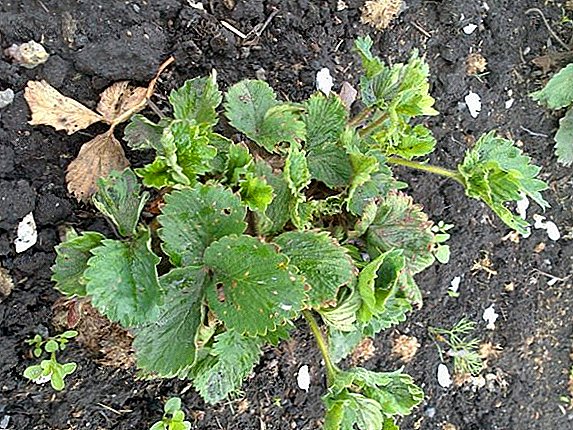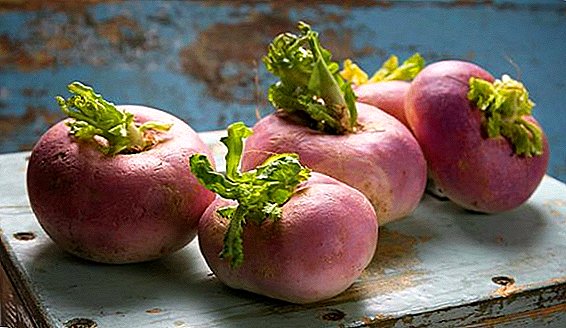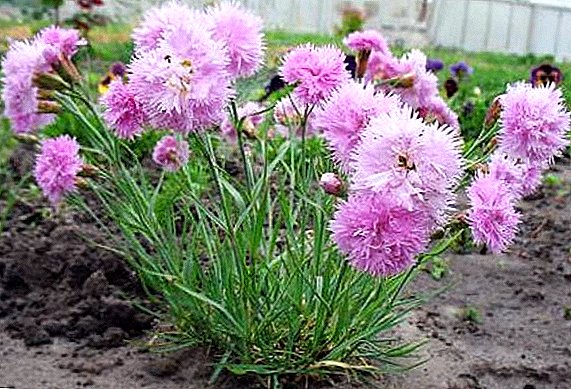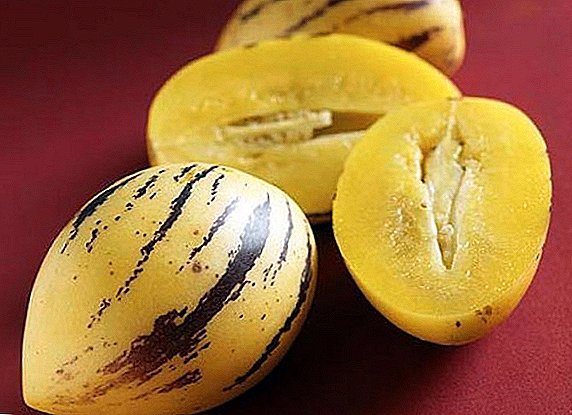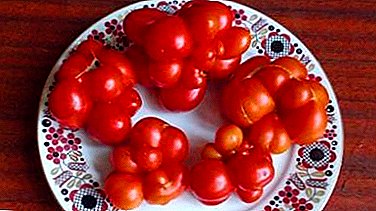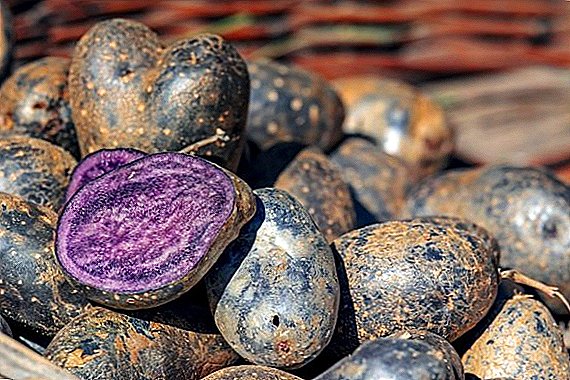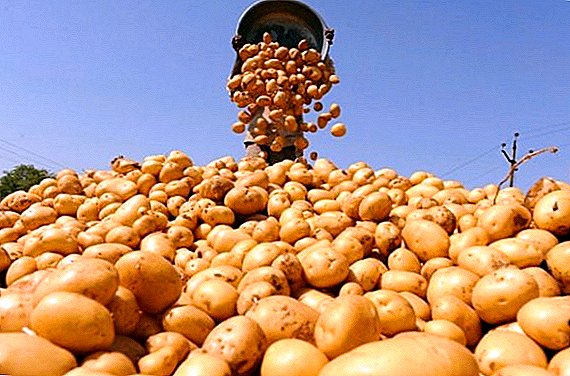 The harvest of potatoes is a source of pride for the gardener and inspires confidence in the future, but this result of many months of effort is easy to destroy with improper storage.
The harvest of potatoes is a source of pride for the gardener and inspires confidence in the future, but this result of many months of effort is easy to destroy with improper storage.
Let's figure out how to store potatoes.
Terms of harvesting potatoes for winter storage
As you know, digging up the harvest begins as early as June-July, however, the young tubers do not tolerate long-term storage, because they have not yet gotten a sufficiently thick skinned. The timing of the final harvest of the “second bread” depends on the weather and on the particular variety, but they usually dig up the harvest by about the beginning of autumn.
It is believed that the potato You can dig when it dries tops. Gardeners usually carry out a control digging of tubers, and based on their condition, weather (it is better to dig on a fine day) and their own experience, they determine the date of harvest.
Did you know? The most expensive potato variety in the world is La Bonnotte. This variety is grown on a small French island of Noirmoutier, located near the Atlantic coast. The cost of local delicacy is about 500 euros per kilogram, the size of the harvest is not more than 100 tons. Tubers are very delicate, the taste is sweetish, with a nutty flavor, have a lemon flavor.
Potato preparation for storage
Harvest harvested before storage must be dried. If there are clear days, and the soil of the garden is sandy, the tubers can be dried directly in the garden, taking them to one place. The process will take several hours, the potato itself is extracted quite dry and clean from the sandy soil.
Much more often, the potatoes are dried under a canopy or inside some household building - this guarantees crop protection from the vagaries of the weather. One or two days is enough for sticking earth to crumble from the tubers and dry their skin. 
Did you know? In the tropical forests, you can find the Solanum wrightii Benth potato tree, which is 15 meters high. True, the tubers of this plant are missing.After drying, the potatoes are laid in a dark room for a couple of weeks - in bulk (no more than half a meter thick) or in bags. During this time, the rind of the potatoes will thicken, and in addition, diseases of individual tubers will appear. At the expiration of such a quarantine period, the tubers are sorted, removing both diseased and mechanically damaged specimens, after which the crop is ready to be stored in the winter.
Potato storage conditions
In order to properly store potatoes, it is very important to observe the temperature regime. The optimum temperature is + 3-5 ° C, while the decisive factor is the stability of this temperature during the entire storage period. At a higher temperature, the tubers sprout over time, take root and become unsuitable for human consumption, and frozen potato tastes sweet because of the formation of starch and sugar in it.
The storage room itself should be dark, isolated from rodents, with constant temperature and ventilation. The floor of the store is covered with sand - it absorbs moisture well. Other moisture absorbing materials for the floor are allowed. It is strictly not recommended to cover the bottom of the store with linoleum, slate, to cement it - all this leads to the accumulation of moisture and the growth of the fungus.
Important! Prolonged natural or artificial lighting leads to the formation of solanine in the potato tubers. Outwardly, it manifests itself as the greening of tubers.
Types of storage in different vaults
Store tubers in bulk, in a continuous layer, and in bags or in boxes. It is much more convenient to store potatoes in a container than in bulk. If it is decided to store the potato tubers in boxes, the boxes in the storage should be located so that air is freely circulating between them. Boxes can be installed on the entire height of the room. When stored in bags and in bulk, the height of the potato layer is set on the basis of the size of the tubers, as well as taking into account the ventilation conditions. Seed potatoes are poured to a height of 1.7 m, and food grade is up to 2.2 m. It is necessary to load potatoes into the store carefully, taking care not to damage the tubers, which can further lead to their rotting and deterioration.
In the fall, nature generously thanks for spring and summer work and, in order to indulge himself a little longer with his own harvest, it is useful to know how to store carrots, watermelons, pumpkins, beets, cucumbers, onions, corn, and garlic.
In the pit
This is quite an archaic way to store the harvest, but, nevertheless, it is still quite often practiced, for example, in summer cottages. However, everyday access to potatoes stored in this way is rather difficult. We will understand how to store potatoes in the pit.  Storage pit is equipped as follows: in a garden or in another convenient place, you need to dig a hole about 2 m in diameter and 1.5 m in depth. The bottom of this pit should be covered with dry straw 30-40 cm, not more. Then potatoes are poured into this storage, but not to the top, you need to leave about 40 cm for the top layer of straw. After laying the top layer of straw, the pit is tightly closed on top of the board and covered with earth up to 80 cm. It is advisable to make ventilation holes in the pit, although this is not necessary.
Storage pit is equipped as follows: in a garden or in another convenient place, you need to dig a hole about 2 m in diameter and 1.5 m in depth. The bottom of this pit should be covered with dry straw 30-40 cm, not more. Then potatoes are poured into this storage, but not to the top, you need to leave about 40 cm for the top layer of straw. After laying the top layer of straw, the pit is tightly closed on top of the board and covered with earth up to 80 cm. It is advisable to make ventilation holes in the pit, although this is not necessary.
On the balcony
If there is no place to store potatoes except in his apartment, then a suitable place for this is a balcony, if, of course, this balcony is stiff and closed. In this case, the tubers are best stored in boxes.
When storing potatoes, the characteristics of the plant variety are a special nuance, so it is important to know what sort of potatoes you will be storing - Kiwi, Gala, Rosara, Good Luck, Anna Koroleva, Golubizna, Adretta, Zhukovskaya Early, Rocco, Ilinskaya, Nevskaya, Slavyanka.Storage in a drawer suggests two options.: in the first case, you can use a standard plank box for vegetables; in the second, a whole container is used, in which the temperature is artificially created.
Storage in ordinary boxes does not provide any additional devices and procedures. Just put the potatoes in the boxes and covered with rags on top. Such storage can withstand temperatures down to -10 ° C. In moderate climates and a closed balcony, potatoes can be stored in bags, spreading oilcloth under them, so as not to spread the dirt, and covering the bags with rags.  For a more severe climate, the second option is preferable. This requires two drawers made of board, plywood or lining. They should be invested in each other like a matryoshka. A smaller box is used directly as a storage chamber for tubers. A bigger box is used as a thermal insulating chamber.
For a more severe climate, the second option is preferable. This requires two drawers made of board, plywood or lining. They should be invested in each other like a matryoshka. A smaller box is used directly as a storage chamber for tubers. A bigger box is used as a thermal insulating chamber.
Between the walls and the bottom of the boxes should be a gap of at least 5 centimeters, which is filled with foam. This container should be closed with a lid. The outer part of this structure is upholstered with linoleum or any other moisture-resistant material, for example, plastic or galvanized iron.
And finally: to maintain a constant temperature in the storage, two 15-25 watt bulbs are installed as heating elements. They are included only with a strong cooling, and they should be darkened with something opaque. Such a container can be installed on the open balcony.
In the cellar
It is believed that it is best to store potatoes in the cellar - this method is known as one of the most effective. To prepare the cellar for the reception of the harvest, it is necessary, first of all, to clean it from debris. It is advisable to disinfect the room by whitewashing it: two kilograms of slaked lime and 200 grams of copper sulphate are added to ten liters of water, all this should be thoroughly mixed and the walls and ceiling should be whitened with the resulting solution.
Important! If disinfection is not carried out, the stored crop may become a victim of the potato moth, the larvae of which damage the tubers. In addition, the risk of fungal diseases of potatoes will significantly increase.About a week later, when the whitewashing will dry completely, you need to check the hoods and fix all the problems, if any. Next, settling itself storage space for potatoes. It can be either shelving for drawers, or shelves for bags that do not come into contact with the floor and walls, or made of bins. The sides of this structure should also not touch the floor and walls. There must be a gap between the boards to improve ventilation. Sprinkle the bottom with sand or straw.

In the basement
Potatoes are stored in the basement in almost the same way as in the cellar. For the best preservation of tubers requires exactly the same whitewash. But, since the basement designs differ from the cellar, it is necessary to monitor both the optimum humidity of 70-80% and the temperature of + 3-5 ° C. It is also necessary to protect the stored crop from any light, because its long-term effect leads to the release of solanine in potato tubers, which is why they turn green.
Types of containers for storing potatoes for storage
Harvested potatoes can be stored in bulk, but containers are often used for storage. The most famous type of container is a bag, plain or mesh. The latter type is preferable, as it provides better ventilation.
Boxes, both wooden and plastic, are widely used for storage. Such boxes, as a rule, are designed for approximately 10 kg of potatoes. The wooden ones are made of slats; slots are provided on the walls and bottom for better ventilation and visual control over the storage item. For plastic boxes, the walls and the bottom are made of mesh for the same purpose. Sometimes, in the presence of a rodent in the repository, use boxes of double metal mesh. In addition to storage boxes, larger containers made of the same wooden slats are used for storage. They can be rectangular or angular. In the lower part of the rectangular containers, a door is often provided for easy removal of the potatoes stored there.
In addition to storage boxes, larger containers made of the same wooden slats are used for storage. They can be rectangular or angular. In the lower part of the rectangular containers, a door is often provided for easy removal of the potatoes stored there.
Modern technologies have not bypassed such a trivial sphere as potato storage. Currently, for these purposes, consumers are offered a kind of mini-cellar, called thermal containers or ovens. Such devices are powered by electricity, they maintain a certain temperature, which the user can regulate.
The capacity of such a mini-cellar is usually 200-300 liters. They can be rigid and flexible, from a special fabric. Flexible are good because in the summer they simply fold out and get out of sight until autumn.
Basic rules for storing potatoes
To guarantee the preservation of the potato crop, you must adhere to certain rules. As stated above, the harvested tubers should be dried and bruised, and the vaults should meet certain criteria. It is more practical to store tubers in containers of 10-15 kg, where for better preservation of the crop, you can lay out a layer of beets (it will protect it from excessive moisture) on top of the potatoes. To slow down the germination of tubers, they enclose apples, quite a few per box.
Thus, with proper preparation for storage of the potato itself, as well as the use of a suitable potato storage facility and compliance with certain rules, the preservation of the harvest will be ensured.



